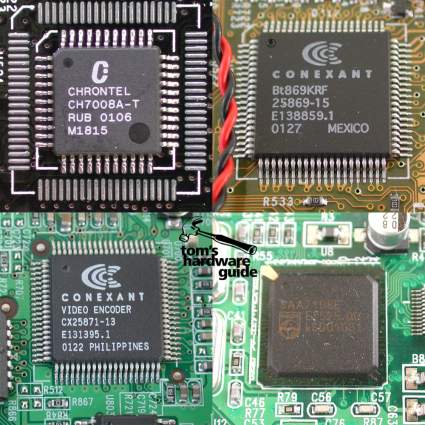Win, Lose or Ti: 21 GeForce Titanium Boards
TV-Out
NVIDIA-based boards use third-party chips for their TV-Out solutions, usually either a Conexant or a Chrontel chip. Cards with additional TV-In capability are the exception, and use a combination chip made by Philips.
One of the biggest drawbacks to NVIDIA's GPUs is that they are only equipped with a single RAMDAC. Consequently, the video signal can only be output at a single refresh rate. When TV-Out is activated, the monitor signal is disabled, since the DAC is already in use. Theoretically, it would still be possible to use the monitor output regardless, because many monitors support the necessary 50Hz mode (for PAL output). After all, a flickering image is better than no image at all. Unfortunately, this feature is disabled in NVIDIA's drivers.
As a result, the usefulness of the TV-Out feature on Titanium cards is very limited. Not only is the usability of the computer reduced, the maximum output resolution is also limited to either 800x600 or 1024x768 (depending on the encoder chip's ability to scale the image).
The results of the various chips with TV-Out:
| TV-Out | PhilipsSAA7108E | ConexantCX25871-13 | ConexantBt868/869 | Chrontel7007A-T | Chrontel7008A-T* | |||||
|---|---|---|---|---|---|---|---|---|---|---|
| System | PAL | NTSC | PAL | NTSC | PAL | NTSC | PAL | NTSC | PAL | NTSC |
| Centered Image 640x480 | Border | OK | Border | Border | Border | Border | Border | Border | - | - |
| Image Size 640x480 | Border | OK | Border | Border | Border | Border | Border | Border | - | - |
| Centered Image 800x600 | OK | OK | Border | Border | Border | Border | Border | Border | - | - |
| Image Size 800x600 | OK | OK | Border | Border | Border | Border | Border | Border | - | - |
| Centered Image 1024x768 | - | - | Border | Border | - | - | - | - | - | - |
| Image Size 1024x768 | - | - | Border | Border | - | - | - | - | - | - |
| Max. Resolution | 800x600 | 1024x768 | 800x600 | 800x600 | - | |||||
| Dual View | - | - | - | - | - |
OK = Output displayed correctlyBorder = Black frame around output, no correction possible*Found on both SUMA models. See text for details.
So, in addition to the hardware limitations, the TV-Out is also impeded by unsatisfactory software. Shareware tools such as TV-Tool are a good investment here, enabling features like Dual View (also called Overscan), Image Zoom and others on cards using Conexant chips, proving that, with a little work and some know-how, an implementation in the drivers should be no problem at all.
Other chipmakers, namely ATi and Matrox, for years have produced boards which are shining examples of what TV-Out should be. The card makers blame NVIDIA, as the company is responsible for 99% of the work on the drivers. NVIDIA, in turn, has shunned responsibility for the TV-Out driver for years. In the end, it is the buyer that suffers from this situation, since the advertised TV-Out features of his or her dream card will more than likely not work as advertised. The reasons behind this shouldn't be of concern to the consumer - they should, however, be of major concern to the company making the product in question. After all, this problem has been known and criticized for years!
Get Tom's Hardware's best news and in-depth reviews, straight to your inbox.
Current page: TV-Out
Prev Page Neighborhood Watch: How To Spot A GeForce3 Next Page Video Capture: Short Clips, If You Please